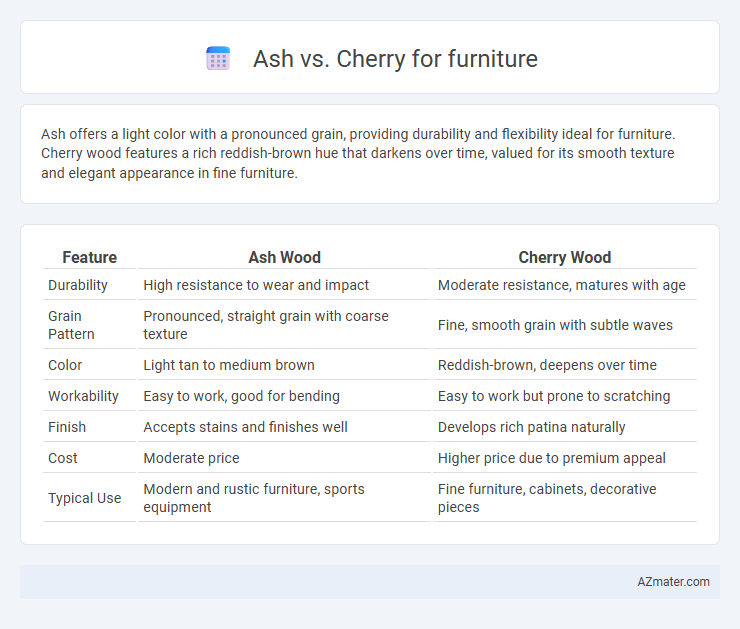Ash offers a light color with a pronounced grain, providing durability and flexibility ideal for furniture. Cherry wood features a rich reddish-brown hue that darkens over time, valued for its smooth texture and elegant appearance in fine furniture.
Table of Comparison
| Feature | Ash Wood | Cherry Wood |
|---|---|---|
| Durability | High resistance to wear and impact | Moderate resistance, matures with age |
| Grain Pattern | Pronounced, straight grain with coarse texture | Fine, smooth grain with subtle waves |
| Color | Light tan to medium brown | Reddish-brown, deepens over time |
| Workability | Easy to work, good for bending | Easy to work but prone to scratching |
| Finish | Accepts stains and finishes well | Develops rich patina naturally |
| Cost | Moderate price | Higher price due to premium appeal |
| Typical Use | Modern and rustic furniture, sports equipment | Fine furniture, cabinets, decorative pieces |
Introduction: Ash vs Cherry Wood in Furniture
Ash and cherry wood are popular choices in furniture making, each offering distinct characteristics that influence durability and aesthetic appeal. Ash wood is prized for its light color, prominent grain patterns, and high strength, making it ideal for pieces requiring resilience and a natural look. Cherry wood, known for its rich reddish-brown hue and smooth texture, darkens with age and exposure, providing a warm, elegant finish favored in traditional and high-end furniture designs.
Wood Characteristics: Grain, Color, and Texture
Ash wood features a straight grain with a coarse texture, providing a smooth yet pronounced surface ideal for furniture that highlights natural wood patterns. Its color ranges from creamy white to light brown, offering a bright and warm aesthetic that complements various interior styles. Cherry wood presents a fine, uniform grain with a satiny texture, richening over time to a deep reddish-brown hue, which adds elegance and warmth to any furniture piece.
Durability and Hardness Comparison
Ash wood offers excellent durability with a Janka hardness rating of approximately 1,320, making it highly resistant to dents and wear in furniture applications. Cherry wood, while prized for its rich color and smooth grain, has a lower Janka hardness of around 950, indicating it is softer and more susceptible to scratches and dents. For furniture requiring robust, long-lasting performance, ash is often preferred due to its superior hardness and ability to withstand heavy use over time.
Workability and Craftsmanship
Ash wood offers excellent workability due to its open grain structure, making it ideal for furniture that requires intricate craftsmanship and smooth finishes. Cherry wood, prized for its fine grain and natural luster, allows for precise carving and ages beautifully, developing a rich patina that enhances custom furniture pieces. Both woods provide strong durability and ease of shaping, but ash is generally preferred for high-impact furniture while cherry excels in detailed, refined designs.
Aesthetic Appeal: Styles and Trends
Ash wood features a light, creamy color with distinctive grain patterns, making it ideal for modern, Scandinavian, and rustic furniture styles that emphasize natural beauty and brightness. Cherry wood offers a rich, warm reddish-brown hue that deepens with age, suiting traditional, classic, and transitional designs that value elegance and timelessness. Current trends favor ash for its versatility and lighter tones in minimalist interiors, while cherry remains popular for luxurious, vintage-inspired pieces.
Cost and Availability
Ash wood is generally more affordable than cherry wood, making it a popular choice for budget-conscious furniture buyers. Ash is widely available in North America, ensuring consistent supply and lower prices, while cherry wood, prized for its rich color and fine grain, tends to be less abundant and more expensive. The higher cost of cherry furniture reflects its premium status and slower growth cycles, impacting availability and market pricing.
Maintenance and Longevity
Ash wood offers excellent durability and a natural resistance to wear, making it low-maintenance for furniture that withstands daily use. Cherry wood develops a rich patina over time but requires regular polishing to preserve its smooth finish and prevent scratches. Both woods provide longevity, with ash excelling in strength and cherry favored for its aesthetic aging qualities.
Environmental Impact and Sustainability
Ash wood is highly valued for furniture due to its rapid growth rate and renewability, making it a more sustainable choice compared to cherry wood. Cherry wood, although durable and aesthetically appealing, grows slower and often requires more intensive forestry practices, resulting in a larger environmental footprint. Choosing ash furniture supports eco-friendly forestry management and reduces deforestation pressures, contributing positively to sustainability goals.
Popular Furniture Types for Ash and Cherry
Ash wood is highly favored for crafting durable, stylish furniture such as chairs, dining tables, and bed frames due to its impressive strength and attractive grain patterns. Cherry wood is renowned for its rich, warm tones and smooth texture, making it a popular choice for elegant cabinets, dressers, and desks. Both materials complement various interior designs, with ash often highlighting contemporary styles and cherry bringing a timeless, classic appeal.
Ash vs Cherry: Which is Right for Your Home?
Ash and Cherry are popular hardwood choices for furniture, each offering distinct characteristics that influence their suitability for different home styles. Ash features a light color with prominent grain patterns, providing a modern and airy aesthetic, while Cherry boasts a rich reddish-brown tone that deepens with age, adding warmth and elegance to traditional or classic interiors. When choosing between Ash and Cherry, consider factors like room lighting, desired color palette, and maintenance preferences to select the wood that best complements your home's environment and design goals.

Infographic: Ash vs Cherry for Furniture
 azmater.com
azmater.com